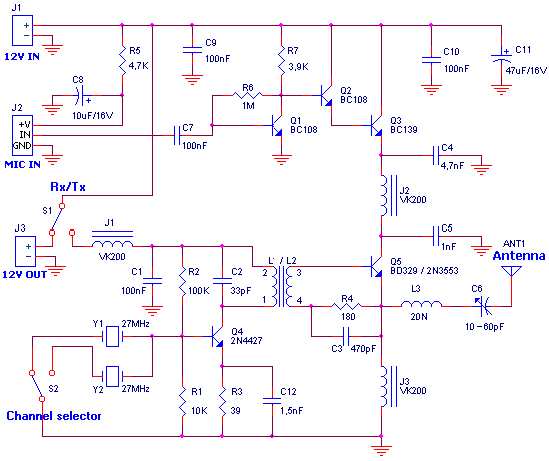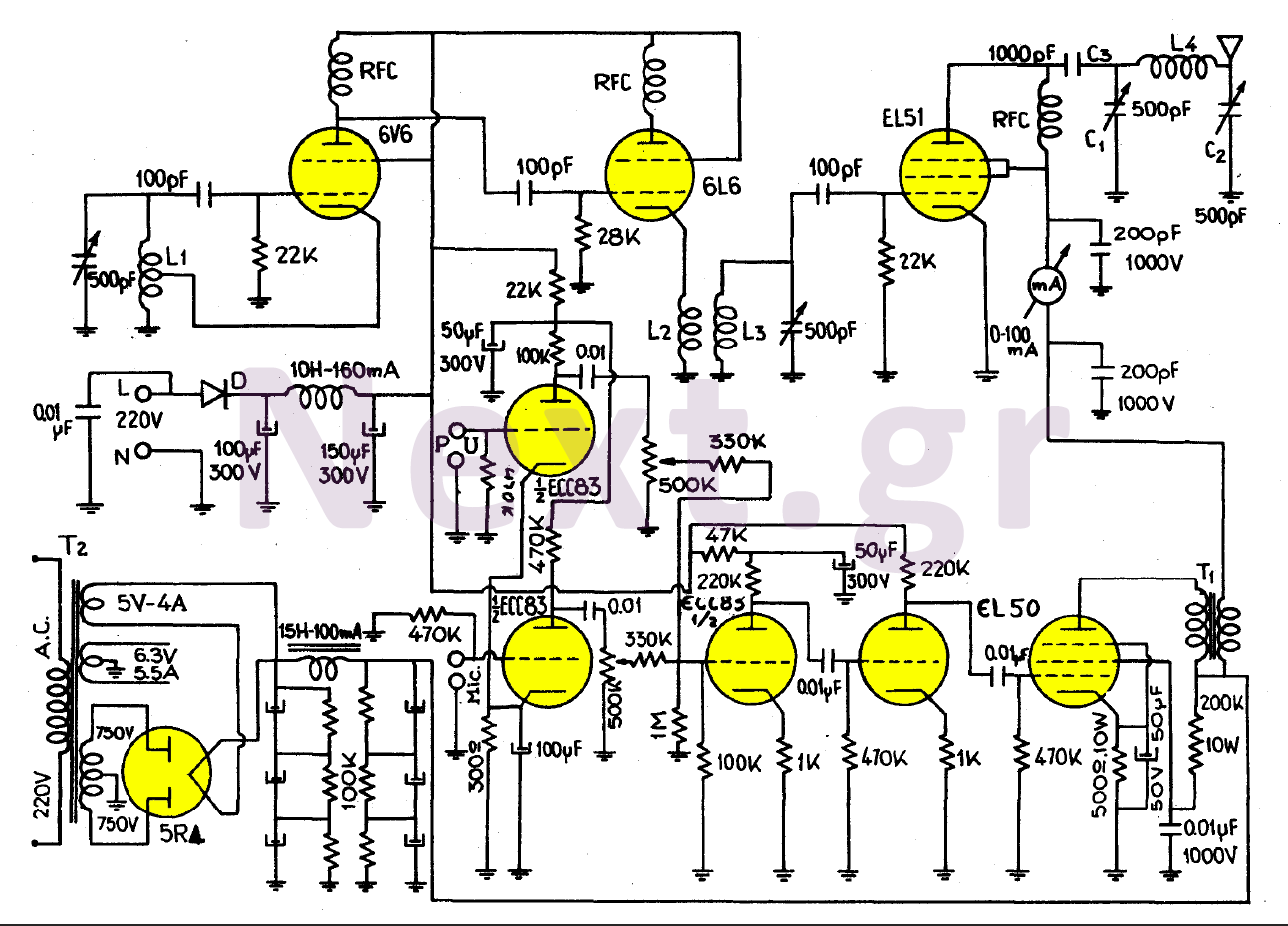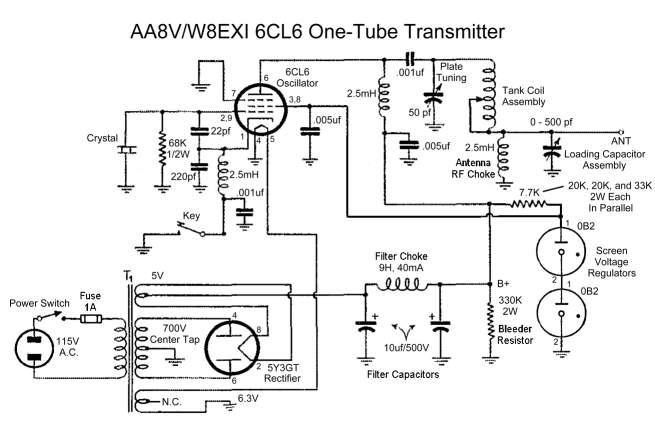
CB transmitter

L1 and L2 are copper wires with a diameter of 0.4 mm, wrapped in a plastic support with a diameter of 6-7 mm, featuring a perjstrofjkoy core. For L1, 13 coils are wrapped, while for L2, 4 coils are wrapped (similar to the receptor CB). ANT1 is an aerial for CB; for initial trials, a piece of wire a few meters long is sufficient, but it is recommended to connect a proper aerial to avoid excessive stagnation and prevent damage to the transmitter. S2 is a switch for selecting channels. There are multiple locations for connecting the desired channels. It is better if S2 is mechanically linked to S1 of the receptor for simultaneous channel changes. A microphone is connected, and when speaking, the multimeter should indicate an increase of approximately 30-35% if everything is functioning correctly.
L1 and L2 serve as the primary inductors in the circuit, providing necessary magnetic coupling for signal transmission. The choice of copper as the wire material ensures minimal resistive losses, while the specified diameter allows for efficient inductance values to be achieved. The plastic support serves to maintain the integrity of the coil structure, preventing any deformation that could affect performance.
The aerial (ANT1) is crucial for effective transmission and reception of CB signals. While a temporary wire may suffice for initial testing, utilizing a properly designed aerial is essential for optimal performance, minimizing signal degradation, and protecting the transmitter from potential overload conditions caused by reflections or standing waves.
S2, the channel selection switch, allows the user to choose between different operational frequencies. The mechanical linkage to S1 enhances user experience by allowing simultaneous channel changes, which is particularly useful in dynamic communication environments.
The microphone connection is integral to the system, providing audio input for transmission. The multimeter serves as a diagnostic tool, enabling the user to monitor output levels. An increase in the multimeter reading by 30-35% during operation indicates proper functionality of the audio input stage, suggesting that the system is effectively converting sound waves into electrical signals for transmission. This feedback loop is essential for ensuring reliable communication in practical applications.L1, L2 Wires of coper (smaltwme`na) with diameter 0, 4mm wrapped in plastic support of diameter 6-7mm of perjstrofjkoy` core. For the L1 you wrap 13 coils. For the L2 you wrap 4 coils. (As in the receptor CB. ) ANT1 Aerial for CB (For the trials is enough a piece wire of few metres but better connects a regular aerial so that does not have many stagnantly and burns the transmitter).
S2 Switch of choice of channel. It has so much places, those who also the channels that you want pja`nete. (Kaly`tera he is mechanically connected with the S1 of receptor for simultaneous change of channels). 4. We connect the microphone and speaking we observe the clue in the multimeter. If all have become right will be supposed the tendency, speaking, to go up roughly 30-35%. 🔗 External reference
L1 and L2 serve as the primary inductors in the circuit, providing necessary magnetic coupling for signal transmission. The choice of copper as the wire material ensures minimal resistive losses, while the specified diameter allows for efficient inductance values to be achieved. The plastic support serves to maintain the integrity of the coil structure, preventing any deformation that could affect performance.
The aerial (ANT1) is crucial for effective transmission and reception of CB signals. While a temporary wire may suffice for initial testing, utilizing a properly designed aerial is essential for optimal performance, minimizing signal degradation, and protecting the transmitter from potential overload conditions caused by reflections or standing waves.
S2, the channel selection switch, allows the user to choose between different operational frequencies. The mechanical linkage to S1 enhances user experience by allowing simultaneous channel changes, which is particularly useful in dynamic communication environments.
The microphone connection is integral to the system, providing audio input for transmission. The multimeter serves as a diagnostic tool, enabling the user to monitor output levels. An increase in the multimeter reading by 30-35% during operation indicates proper functionality of the audio input stage, suggesting that the system is effectively converting sound waves into electrical signals for transmission. This feedback loop is essential for ensuring reliable communication in practical applications.L1, L2 Wires of coper (smaltwme`na) with diameter 0, 4mm wrapped in plastic support of diameter 6-7mm of perjstrofjkoy` core. For the L1 you wrap 13 coils. For the L2 you wrap 4 coils. (As in the receptor CB. ) ANT1 Aerial for CB (For the trials is enough a piece wire of few metres but better connects a regular aerial so that does not have many stagnantly and burns the transmitter).
S2 Switch of choice of channel. It has so much places, those who also the channels that you want pja`nete. (Kaly`tera he is mechanically connected with the S1 of receptor for simultaneous change of channels). 4. We connect the microphone and speaking we observe the clue in the multimeter. If all have become right will be supposed the tendency, speaking, to go up roughly 30-35%. 🔗 External reference





